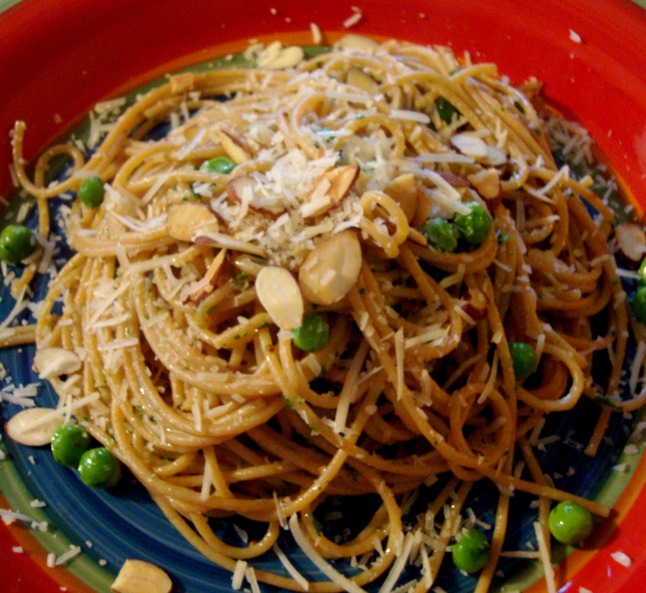Parsley pesto pasta with peas - a celebration of fresh herbs

Mary Bilyeu | Contributor
I just happened to have some parsley on hand, so I put it to good use — I made a pesto. Many people think that pesto is made with basil; it can be, absolutely! But pesto is actually a paste made by grinding ingredients together with a mortar and pestle; thus, basil or parsley or any other fabulous, fragrant items can be used.
Pesto and pasta are natural partners, each having a particular affinity for the other. And since I was amused by that alliteration, I also thought I'd toss in some peas, too, to go with my parsley pesto and pasta. A few toasted almonds for crunch and extra flavor (peanuts, despite their first initial, just didn't sound right), and a quick, easy, delicious dinner was served...
Parsley Pesto Pasta with Peas
1 12-ounce package whole wheat spaghetti
1 cup frozen peas
1 cup flat-leaf Italian parsley leaves
2 tablespoons garlic paste
1 tablespoon stone ground garlic mustard (or Dijon mustard)
1/2 cup extra-virgin olive oil
pinch of kosher salt
pinch of red pepper flakes
1/3 cup sliced almonds, lightly toasted
shredded Parmesan, for serving
Prepare spaghetti according to package directions, adding peas for the last minute of cooking.
Meanwhile, purée parsley, garlic paste, mustard, olive oil, salt, and red pepper flakes in a blender until mostly smooth. When pasta is ready, drain it and return it to the pot; pour the pesto over it and toss to coat.
Place spaghetti onto a serving platter, then sprinkle with almonds and with Parmesan.
Serves 4-6.

Go visit Mary's blog — Food Floozie — where she enthuses and effuses over all things food-related; and look for her monthly articles in the Washtenaw Jewish News. "Like" her on Facebook, or send a tweet on Twitter, too.
The phrase "You Should Only Be Happy" (written in Hebrew on the stone pictured in this post) comes from Deuteronomy 16:15 and is a wish for all her readers - when you come to visit here, may you always be happy.


Comments
Lola
Thu, May 9, 2013 : 5:38 p.m.
You could have used pignolis!